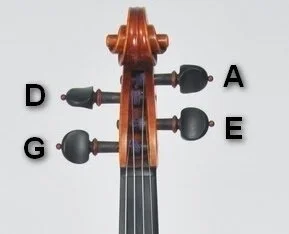How do I replace my strings?
If you want to replace all the strings, it is easiest to replace the strings one by one. This prevents the soundpost from falling out and the bridge from shifting or falling over. The bridge is not attached to the instrument, but is held in the correct position by the tension of the strings.
It does not matter in which order you replace the strings, you usually start at the side with the G or E string.
If the string has a fine tuner, place the 'ball end' in the fine-tuning mechanism and pull the string over the bridge to the peg. Make sure there is light tension on the lower part of the string so that it does not immediately come loose from the fine tuner. Be careful that the fine tuner does not rub against the top and damage it (turn the fine tuner all the way back when putting on the string).
Place strings without fine tuners in the hole in the tailpiece and then pull them over the bridge to the peg. Sometimes the hole in the tailpiece is a bit too narrow, so you can file it lightly.
Then insert the end of the string through the peg hole, making sure that the string extends a few millimetres on the other side of the peg hole. Now slowly tighten the string. Push the key further into the hole as you wind the string, making sure to wind the string from the peg hole to the side of the scroll (the string should not twist on itself). Apply enough pressure so that the peg does not slip.
If you are replacing all the strings at the same time, wind the strings somewhat evenly and do the tuning at the end. Check whether the bridge remains perpendicular to the top (it has a tendency to bend forward - towards the scroll). If not, adjust the bridge slightly and then tighten the strings further.
You will have to tune a new string more often in the beginning.
If the peg snaps back, you can buy peg soap to prevent this (soap the peg where it makes contact with the peg hole).
You can also use a pencil to put some graphite in the grooves of the bridge (the notches in the bridge where the strings run). This ensures that the strings run more smoothly and tension more easily.
Order of the strings. For the pegs: G = bottom left, D = top left, A = top right and E = bottom right. At the tailpiece: G – D – A – E (see also the picture below).
Order of the violin strings
And when should I replace my strings?
If you clean your strings regularly, this will prolong their lifespan. Perspiration from your fingers also has an influence. If you have dry fingers, the strings will last longer. If you play for a few hours every day, a set will last an average of about 6 months. If you play less often, strings will last longer. As a rule, you should replace strings at least once a year. But this also depends on what requirements you set. It is certainly possible to use strings for longer.

